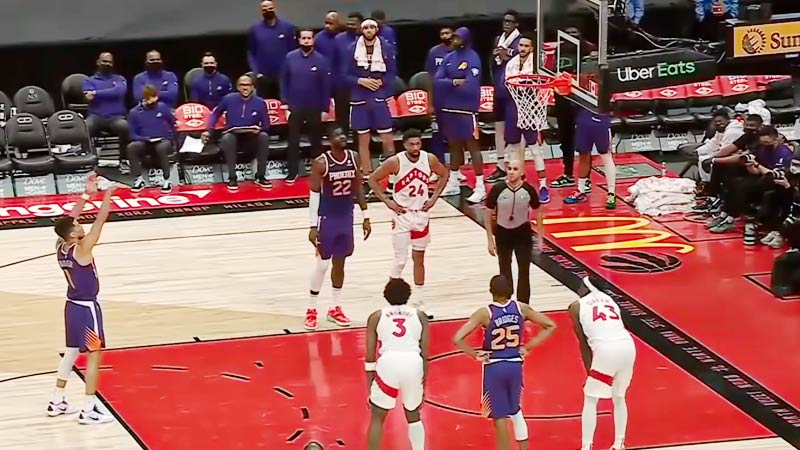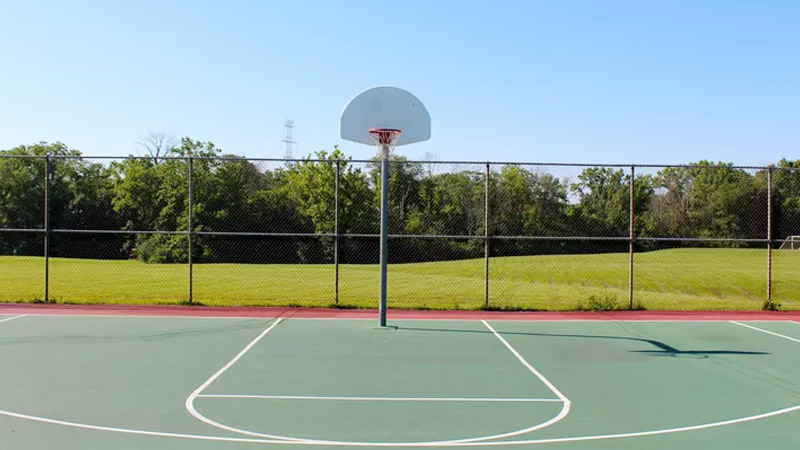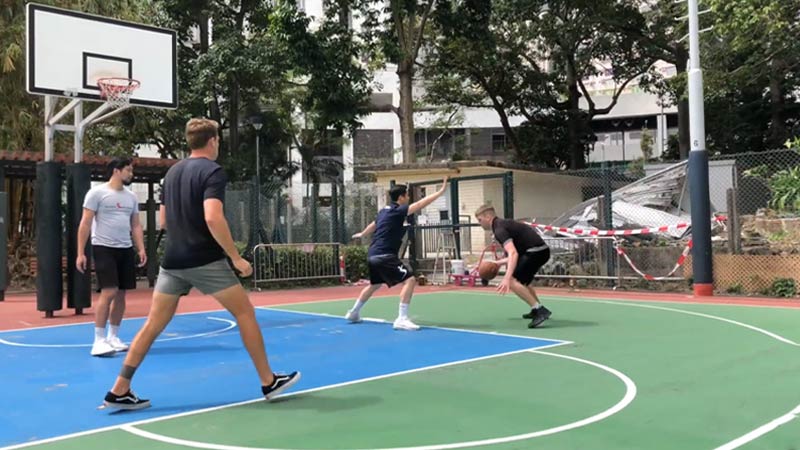Basketball is a versatile sport that can be played in various formats and settings. One such format is the half-court basketball game.
While traditional basketball is typically played on a full court, half-court basketball offers a more compact and fast-paced alternative.
In this article, we will explore the rules and intricacies of half-court basketball, providing a comprehensive guide to this exciting variation of the game. So, let’s dig into the matter in the following phases.
What Is Half-Court Basketball?
Half-court basketball refers to a modified version of the traditional game where only one-half of a standard basketball court is used.
In contrast to the full-court game, which typically involves teams of five players, half-court basketball is played with three players per team.
This reduction in court size and player count creates a fast-paced and dynamic playing environment that requires adjustments in strategy and gameplay.
Adapting to the Smaller Court
The smaller court size in half-court basketball necessitates changes in player positioning, movement, and overall strategy. With less space available, players must be more efficient in their movements, passing, and shooting.
The condensed playing area leads to quicker transitions between offense and defense, requiring players to have strong situational awareness and decision-making skills.
What Are Half-Court Basketball Rules?
While some rules in half-court basketball remain the same as in the traditional game, there are specific rule adaptations to accommodate the reduced court size and player count.
Here are some key rules commonly associated with half-court basketball:
Scoring
Teams typically play to a designated point total, such as 11 or 15 points. Some variations include assigning different point values to shots made from different areas of the court, such as inside the arc or beyond the three-point line.
Out-of-Bounds
The out-of-bounds lines are adjusted to fit the half-court dimensions. Players must ensure they stay within the boundaries of the designated half-court area during play.
Check Ball
After each made basket or dead ball situation, the opposing team starts with a check ball at the top of the key. This eliminates the need for full-court inbound passes and allows for quicker transitions.
Defensive Rules
Some half-court games may have specific rules regarding defensive positioning, such as prohibiting defenders from double-teaming or requiring them to play man-to-man defense.
Shot Clock
In certain half-court games, a shot clock may be used to limit the time a team has to attempt a shot. This rule helps maintain the pace of the game and prevents excessive stalling.
What Are the Penalties for Half-Court Basketball Rules?

In half-court basketball, just like in traditional basketball, penalties are in place to uphold fairness, discourage unsportsmanlike behavior, and maintain the integrity of the game.
These penalties act as consequences for rule violations, ensuring that players adhere to the established guidelines and play within the boundaries of fair play. Let’s delve into some common penalties in half-court basketball:
Turnover of Possession
One of the most prevalent penalties in half-court basketball is the turnover of possession. This occurs when a team commits a violation, such as traveling, double dribbling, or stepping out of bounds.
In such cases, the opposing team is awarded possession of the ball, providing them with an opportunity to attack and score.
Free Throws
Depending on the specific rules of the half-court game being played, certain violations may result in the opposing team being awarded free throws. Free throws typically occur when a foul is committed, such as illegal contact, pushing, or holding.
The fouled player is allowed to shoot unopposed from the free throw line, with the number of free throws granted varying based on the severity of the foul and the specific rules in place.
Loss of Points
In some instances, particularly in competitive half-court basketball games, violations may lead to a loss of points.
For example, if a team is found guilty of unsportsmanlike conduct or technical fouls, they may have points deducted from their overall score.
This penalty serves as a deterrent against undesirable behavior and encourages players to compete with sportsmanship and respect.
Expulsion or Disqualification
In cases of severe rule violations or repeated unsportsmanlike behavior, a player may face expulsion or disqualification from the game. This penalty is reserved for situations that significantly breach the rules or endanger the safety of other players.
Expulsion or disqualification removes the player from the game entirely and may have further consequences, such as suspensions or fines, depending on the level of play and governing organization.
By enforcing these penalties, half-court basketball ensures that players understand the consequences of violating the rules.
Penalties maintain fairness, discourage unsportsmanlike conduct, and help create an environment where the integrity of the game is preserved.
Significance of Half-Court Basketball Rules

Source: sportsrec.com
Half-court basketball rules hold significant importance in shaping the dynamics and overall experience of the game. As a modified version of the full-court game, half-court basketball introduces specific rules that adapt to the reduced playing area.
Let’s explore the significance of these rules and how they contribute to the flow, competitiveness, and strategic elements of the game.
Enhanced Player Engagement
By implementing half-court basketball rules, players are constantly involved in the action, leading to increased engagement and participation.
With a smaller playing area, players have fewer spaces to cover, resulting in a faster-paced and more intense game.
The condensed space encourages constant movement, decision-making, and active participation from all players, making the game more exciting and engaging.
Promoting Fair Play
Half-court basketball rules contribute to fair play by ensuring equal opportunities for both teams. With limited space, it becomes crucial for teams to efficiently utilize their possessions and maximize scoring opportunities.
The rules aim to prevent one team from dominating the game, allowing for a more balanced and competitive experience. Fair play is fostered through rules such as shot clocks, time limits, and restrictions on player positioning.
Strategic Elements
Half-court basketball rules introduce strategic elements that require players and teams to employ smart tactics and game plans. The smaller court size places a premium on ball movement, spacing, and effective communication.
Teams must make quick decisions, create scoring opportunities through effective passing and cutting, and employ efficient defensive strategies within the limited space.
These rules enhance the strategic aspect of the game, encouraging players to think critically and execute plays with precision.
Skill Development
Playing half-court basketball allows players to focus on specific skills and aspects of the game. With a reduced court size, players have more opportunities to work on individual offensive moves, defensive techniques, and overall basketball fundamentals.
The concentrated gameplay encourages players to improve their shooting accuracy, ball-handling skills, court vision, and defensive positioning.
This emphasis on skill development enhances player growth and contributes to the overall improvement of the game.
Social Interaction and Team Building
Half-court basketball provides an excellent platform for social interaction and team building. With fewer players on the court, there is increased communication and collaboration among teammates.
Players must rely on effective teamwork, coordination, and understanding of each other’s strengths and weaknesses to achieve success.
The smaller teams foster a sense of camaraderie, allowing players to build relationships, develop leadership skills, and work towards a common goal.
The significance of half-court basketball rules lies in their ability to shape the dynamics of the game, enhance player engagement, promote fair play, and introduce strategic elements.
FAQs
Are the basic rules of basketball applicable to half-court basketball as well?
Yes, many basic rules of basketball, such as traveling, fouls, and violations, still apply in half-court basketball.
However, there are specific adaptations and modifications to accommodate the reduced court size and the number of players.
How many players are typically on each team in half-court basketball?
In half-court basketball, three players per team are commonly used. This reduced number allows for more space and facilitates faster gameplay.
Is the scoring system the same in half-court basketball?
The scoring system remains the same in half-court basketball, with two points awarded for a field goal and one point for a free throw.
However, due to the smaller court size, three-pointers may be adjusted or eliminated depending on the specific rules being followed.
Are there any specific rules regarding offensive strategies in half-court basketball?
While offensive strategies can vary, some common rules in half-court basketball may include a shot clock or time limit for possessions to ensure continuous gameplay and prevent stalling tactics.
How does the out-of-bounds rule work in half-court basketball?
In half-court basketball, the out-of-bounds rule typically follows the same principles as in full-court basketball.
If the ball goes out of bounds, possession is awarded to the opposing team, and play resumes from the sideline or baseline, depending on the situation.
Conclusion
Half-court basketball offers a thrilling and dynamic variation of the traditional game, providing players with unique challenges and opportunities.
The rules and nuances of half-court basketball are essential for anyone looking to engage in this fast-paced and exciting version of the sport.
By adhering to the rules, players can enjoy fair play, strategize effectively, and fully embrace the energy of the game within limited space.
So grab a ball, find a half-court, and experience the exhilaration of half-court basketball firsthand. Best of luck.







